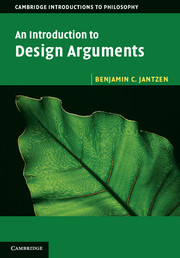Book contents
- Frontmatter
- Dedication
- Contents
- List of figures and tables
- Preface
- 1 Introduction
- 2 Preliminaries
- 3 Arguments from antiquity
- 4 Medieval arguments
- 5 The golden age of natural theology
- 6 Unusual design arguments
- 7 Hume
- 8 Paley
- 9 Darwin
- 10 Loose ends
- 11 The modern likelihood argument
- 12 Intelligent design I: irreducible complexity
- 13 Intelligent design II: specified complexity
- 14 What is complexity?
- 15 Supernatural agents and the role of laws
- 16 A brief survey of physical law
- 17 Fine tuning I: positive arguments
- 18 Fine tuning II: objections
- 19 Conclusion
- Bibliography
- Index
19 - Conclusion
Published online by Cambridge University Press: 05 June 2014
- Frontmatter
- Dedication
- Contents
- List of figures and tables
- Preface
- 1 Introduction
- 2 Preliminaries
- 3 Arguments from antiquity
- 4 Medieval arguments
- 5 The golden age of natural theology
- 6 Unusual design arguments
- 7 Hume
- 8 Paley
- 9 Darwin
- 10 Loose ends
- 11 The modern likelihood argument
- 12 Intelligent design I: irreducible complexity
- 13 Intelligent design II: specified complexity
- 14 What is complexity?
- 15 Supernatural agents and the role of laws
- 16 A brief survey of physical law
- 17 Fine tuning I: positive arguments
- 18 Fine tuning II: objections
- 19 Conclusion
- Bibliography
- Index
Summary
Recapitulation
Most of the design arguments appearing in this book can be viewed as variations on a handful of themes already present in Stoic thought by the first century BCE. I’ve been calling these the argument from order, the argument from purpose, the argument from providence, and the argument by analogy (see Chapter 3). Though I often refer to them in the singular, each is really a family of arguments united by a common schema, a logical form with placeholders for premises that can be filled in a variety of ways. So to be more precise in this review, I’ll refer to the arguments from order, etc.
The arguments by analogy assert that, given all the ways in which the universe resembles a machine, we should conclude that it also resembles a machine in having a designer. This family of arguments was brought into its sharpest focus and then undermined by David Hume (see Chapter 7). The arguments from purpose appeal to natural phenomena, especially the ways in which living things are adapted to their environment, that are supposed to self-evidently exhibit purpose. In Chapter 10, we saw that we must disambiguate senses of ‘purpose’ to avoid begging the question. After all, what we are trying to establish is whether any portion of the natural universe was purposefully arranged by a designing intelligence. But when this is done the argument collapses – it is not the case that the sort of ‘purpose’ which can be observed in the natural world entails or even suggests design.
- Type
- Chapter
- Information
- An Introduction to Design Arguments , pp. 311 - 315Publisher: Cambridge University PressPrint publication year: 2014



